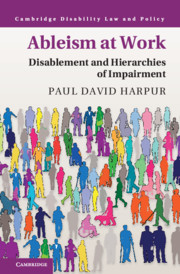Book contents
- Ableism at Work
- Cambridge Disability Law and Policy Series
- Ableism at Work
- Copyright page
- Contents
- Foreword
- Acknowledgements
- 1 Introduction
- 2 International Disability Norms at Work
- 3 The CRPD Committee, Ableism and Hierarchies of Impairment at Work
- 4 Hierarchies of Impairment at Work in the Regulation and Response to Sheltered Work
- 5 The Arbitrary Exclusion of Episodic and Psychosocial Disabilities from Legal Protection
- 6 Ability Apartheid at Work
- 7 Reasonable Accommodations in a Psychosocial Diverse Workplace
- 8 Using Occupational Safety and Health Laws to Promote Psychological Health at Work
- 9 Sanism and Ableism in the Law’s Response to Injured Workers
- 10 Advancing Psychosocial Diversity Using Contract and Unfair Dismissal Laws
- Index
4 - Hierarchies of Impairment at Work in the Regulation and Response to Sheltered Work
Published online by Cambridge University Press: 06 August 2020
- Ableism at Work
- Cambridge Disability Law and Policy Series
- Ableism at Work
- Copyright page
- Contents
- Foreword
- Acknowledgements
- 1 Introduction
- 2 International Disability Norms at Work
- 3 The CRPD Committee, Ableism and Hierarchies of Impairment at Work
- 4 Hierarchies of Impairment at Work in the Regulation and Response to Sheltered Work
- 5 The Arbitrary Exclusion of Episodic and Psychosocial Disabilities from Legal Protection
- 6 Ability Apartheid at Work
- 7 Reasonable Accommodations in a Psychosocial Diverse Workplace
- 8 Using Occupational Safety and Health Laws to Promote Psychological Health at Work
- 9 Sanism and Ableism in the Law’s Response to Injured Workers
- 10 Advancing Psychosocial Diversity Using Contract and Unfair Dismissal Laws
- Index
Summary
The CRPD recognises that the measures that are appropriate for one category and severity of impairment may not be appropriate for others. This leads to substantial challenges for crafting regulatory options that support the most vulnerable people in the disability community, without holding back those who are more able, as well as not adopting models which enable those who can become highly competitive in the open labour market to do so at the expense of those who cannot. These policy challenges are being experienced when considering the right to work and the sheltered work debate. In 1955, the ILO issued a recommendation that called for the adoption of sheltered work arrangements for workers “who cannot be made fit for ordinary competitive employment … for those disabled persons who, for physical, psychological or geographical reasons, cannot travel regularly to and from work.”[1] The regulation of ability diversity at work has substantially shifted over the last few decades and, as analysed in this chapter, there has been considerable pressure inside and outside the disability community to close sheltered workshops.
- Type
- Chapter
- Information
- Ableism at WorkDisablement and Hierarchies of Impairment, pp. 54 - 80Publisher: Cambridge University PressPrint publication year: 2019

